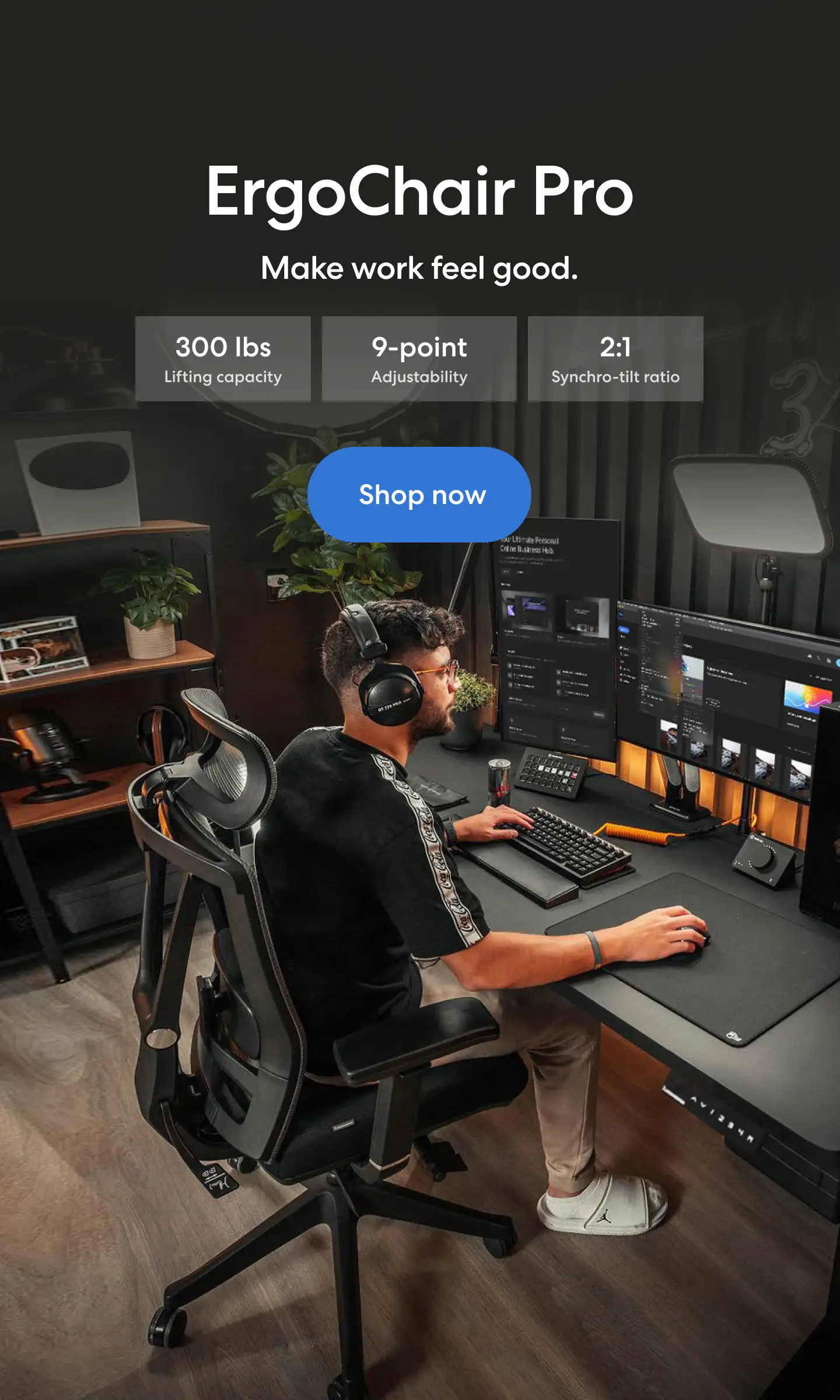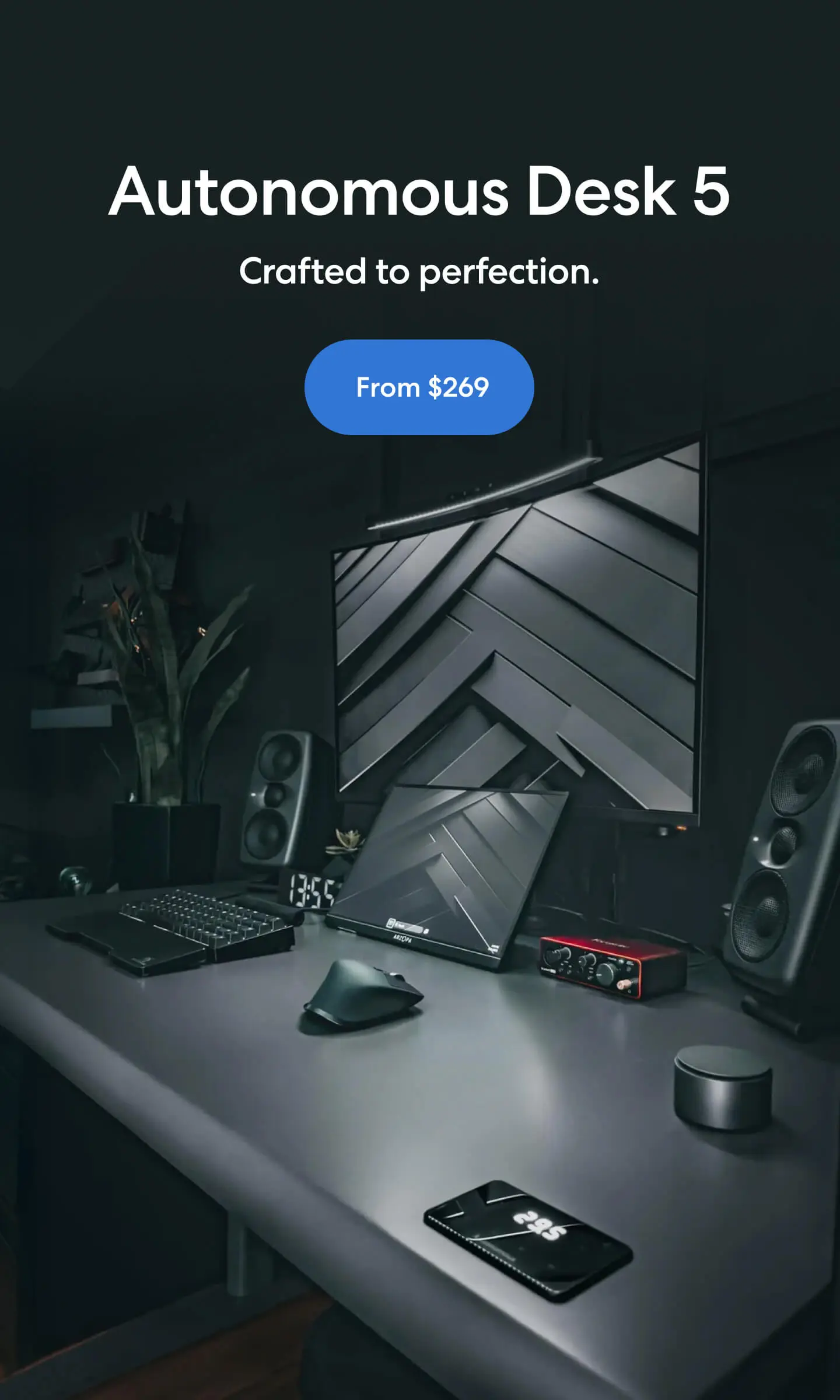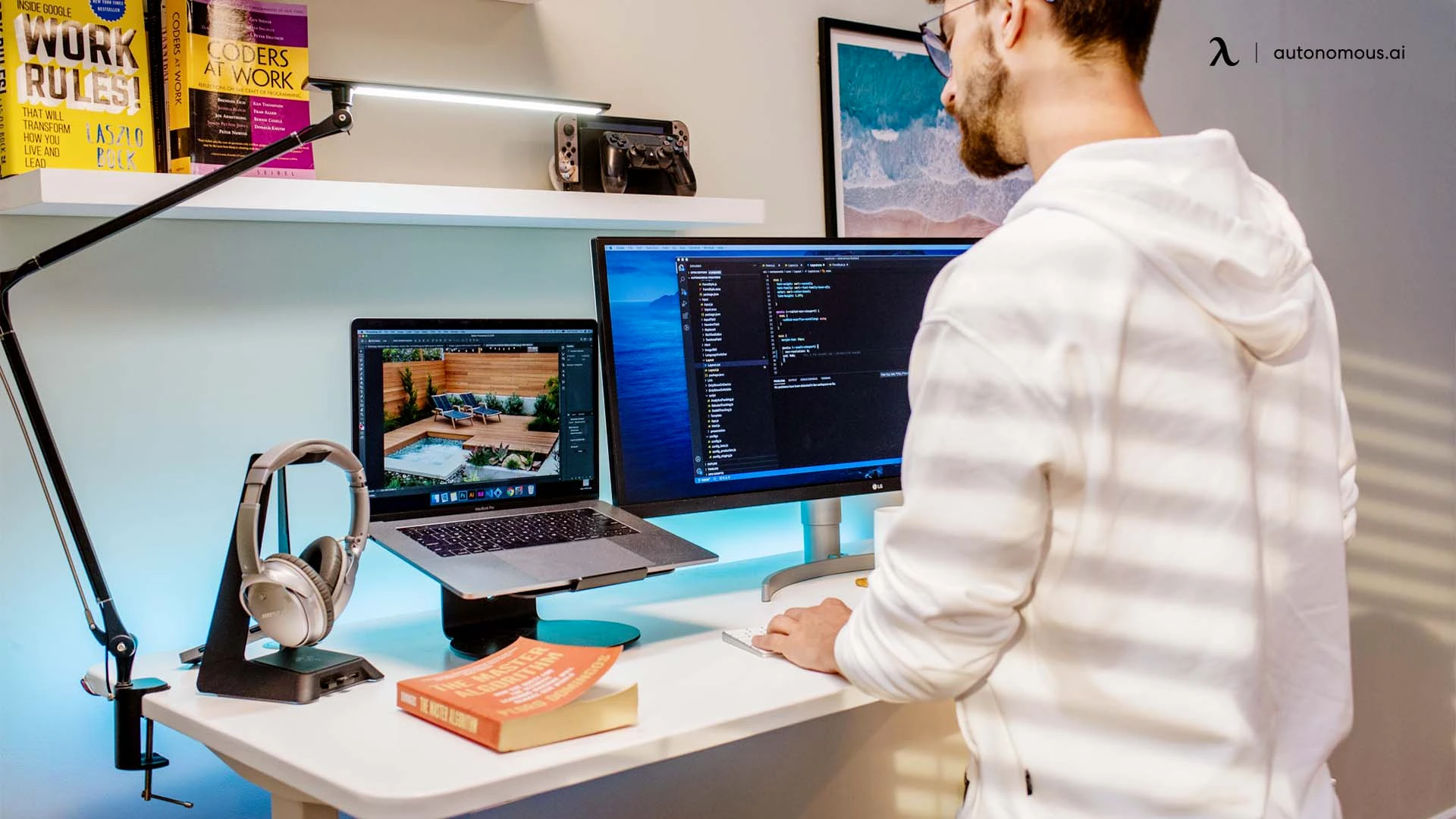
Table of Contents
If back pain has become your daily reality, you’re not alone. Millions of people working from desks suffer from the strain of sitting for hours, tight hips, aching lower back, and stiff shoulders. But a growing number of professionals are discovering a simple, powerful solution: the standing desk for lower back pain. These height-adjustable desks let you move more freely and work in alignment with your body, not against it. In this guide, I’ll break down how standing desks help relieve back pain and recommend a few that are worth every penny.
How Sitting Triggers Back Pain
Back pain isn’t just a personal problem—it’s a modern epidemic, especially among people who work at a desk for most of the day. Sitting for long periods, especially in poor posture, puts the body in an unnatural position. Here’s why that matters:
- Spinal Compression: When you sit, especially with a rounded back or slouched shoulders, your spine is compressed. This increases pressure on the lower discs in your lumbar spine, which can lead to discomfort, inflammation, or even herniated discs over time.
- Tight Hip Flexors and Hamstrings: Sitting keeps your hips in a flexed position, which shortens and tightens the muscles in your hips and thighs. These tight muscles pull on your pelvis, which can tilt it out of alignment and lead to lower back strain.
- Weakened Core and Postural Muscles: Prolonged sitting turns off your core muscles. Without these muscles engaging regularly, your spine doesn’t get the support it needs. Over time, you lose strength in the muscles that keep your posture upright.
- Reduced Blood Circulation: Staying in one position slows down circulation. This can lead to stiffness, fatigue, and discomfort in your lower back, legs, and even shoulders.
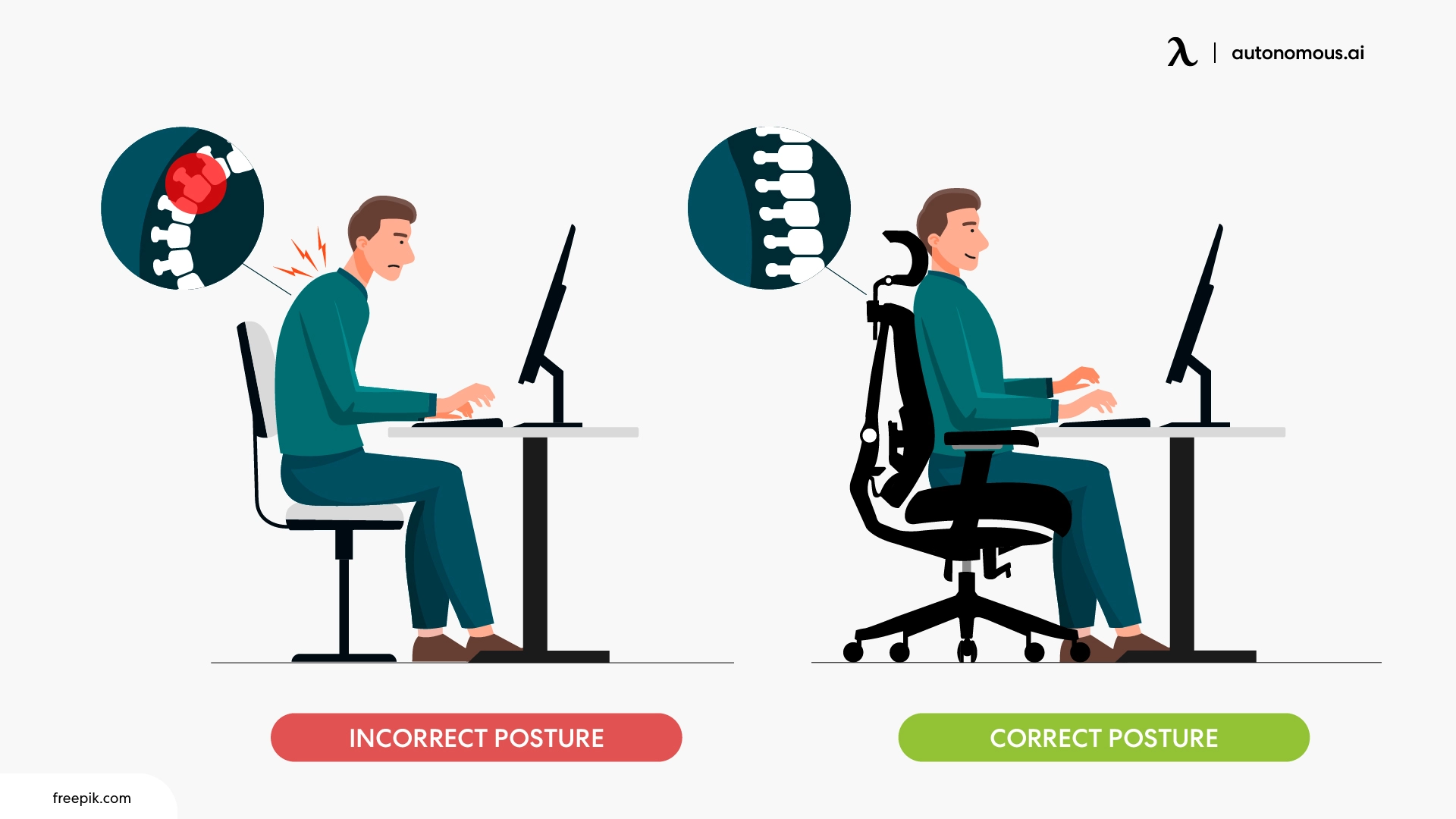
Why Standing Desks Make A Difference
A standing desk lets you alternate between sitting and standing, giving your body a chance to reset its posture, engage new muscles, and stay energized. So if you’re wondering, “is a standing desk good for back pain?”—the answer is yes, especially when used as part of a balanced sit-stand routine. Here’s a detailed breakdown of the benefits of a standing desk:
- Reduces Pressure on the Spine
Standing helps decompress your spine. When you’re upright, your body distributes weight more evenly through your feet and legs, instead of loading it all into your lower back and tailbone like when you’re seated. Less pressure means fewer aches and less risk of developing chronic pain. This is why using a standing desk for lower back pain can be especially effective.
Promotes Natural Movement
Unlike sitting, standing encourages small movements—shifting your weight, stretching your legs, even pacing for a few seconds. These micro-movements stimulate blood flow, reduce muscle fatigue, and keep your joints and spine from getting stiff or locked in one position. If you’re interested in the physical effects, a standing desk can help you burn calories while staying focused on your workflow.
Engages Core and Postural Muscles
When you stand with proper posture, your abdominal muscles, glutes, and back stabilizers activate to support you. This gentle engagement strengthens those muscles over time, which improves posture and reduces the strain on your lower back when you sit down.
Encourages Better Posture
Standing makes it easier to notice when you’re slouching. Plus, a standing desk for back pain often comes with adjustable monitor arms or risers, making it easier to align your screen at eye level. This helps prevent forward head posture—a major cause of neck and upper back pain. So when people ask, “Are standing desks good for your back?”—it’s not just about standing; it’s about promoting the kind of movement and proper standing desk posture that supports a healthier spine. One of the differences between a standing desk and a sitting desk is that a standing desk reminds you to stay active frequently without disrupting your productive workflow.
Breaks Up Prolonged Inactivity
The key benefit isn’t just standing—it’s having the option to switch positions frequently. Experts recommend the “sit-stand-switch” method: rotate between sitting and standing every 30–60 minutes. This variation keeps your muscles engaged and your posture dynamic, helping to prevent stiffness and muscle imbalance.
A standing desk doesn’t mean you have to be on your feet all day. Instead, it gives you the flexibility to move, realign, and support your spine throughout the workday. That’s what makes it such a powerful tool for anyone struggling with back pain. Over time, this movement can contribute to overall wellness and even support gradual weight management. You can learn more about this connection in our guide to using a standing desk for weight loss.
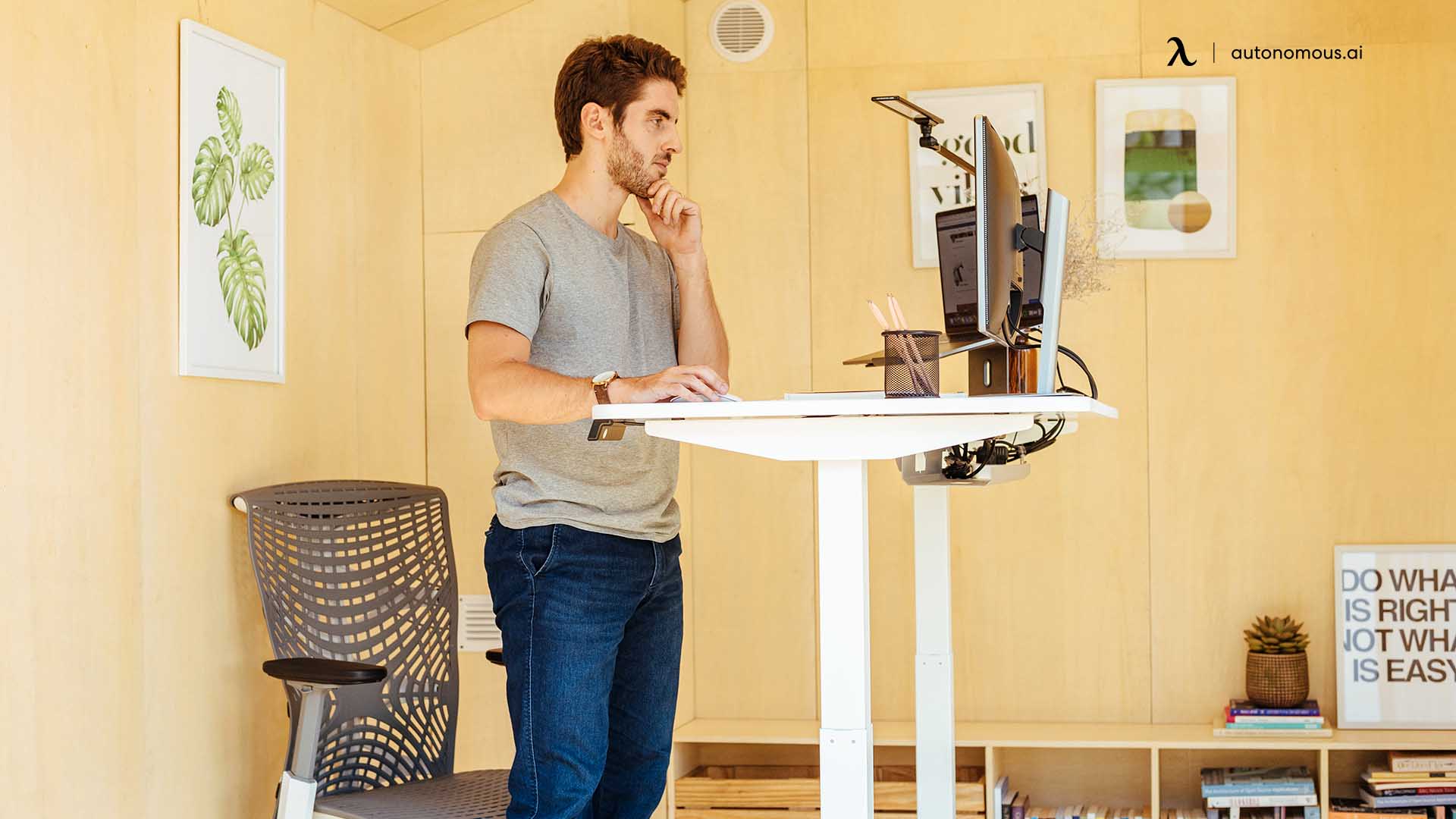
What To Look For In A Standing Desk For Back Pain Relief
Not all standing desks for back pain are created equal. If you’re dealing with back pain, here’s what matters to consider before buying any model:
- Smooth, quiet height adjustment (electric preferred)
- Wide height range to accommodate proper screen and elbow positioning
- Strong, stable frame to prevent wobble and strain
- Programmable memory presets for easy transitions
- Spacious surface for monitor arms and ergonomic accessories
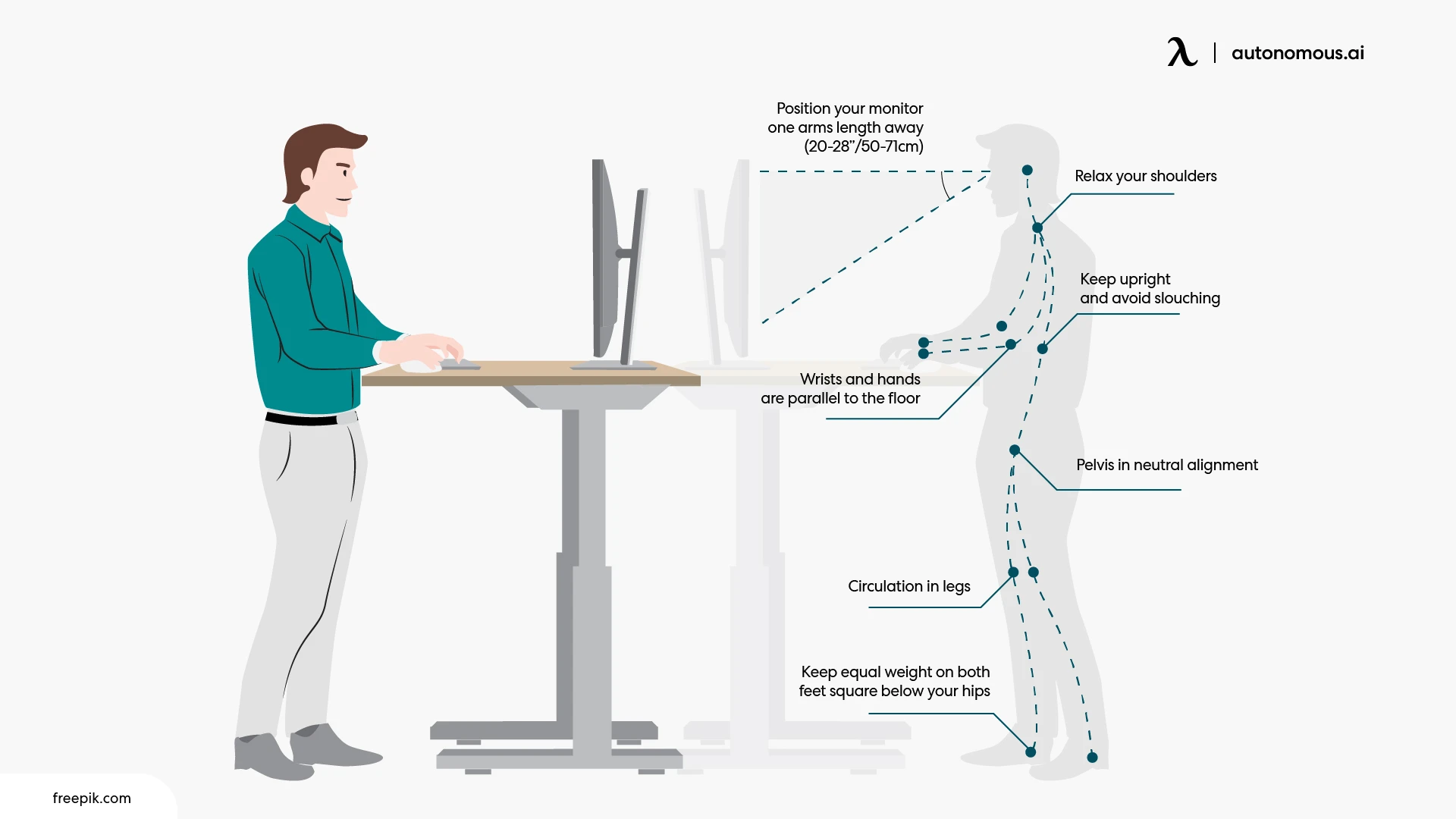
The Best Standing Desks For Back Pain
Whether you’re already dealing with back discomfort or just want to prevent it, investing in a standing desk designed with ergonomics in mind can make a huge difference. Here are the top-rated standing desks for back pain that combine stability, ease of use, and posture-friendly features.
1. Autonomous Desk 2
Best Entry-Level Option for Basic Back Support
The Autonomous Desk 2 is a fantastic entry-level option for those looking to transition to standing desks. It's perfect for improving posture and alleviating back strain without breaking the bank. Featuring a whisper-quiet dual-motor system and a dependable height range that accommodates most users, this desk is well-suited for remote workers crafting their first home office with a simple and clean standing desk setup, students in tight quarters, freelancers in need of a compact solution, or anyone eager to embrace the basics of ergonomic posture. Moreover, this product from Autonomous may be the best standing desk for short people who want to integrate this new step into their working routine.
.jpg)
Autonomous Desk 2
| Top | Classic Top |
|---|---|
| Dimensions | 53"L x 29"W x 1"H |
| Shipping dimensions | 56"L x 33"W x 3"H x 47 lbs |
| Colors | White, Black, Walnut, White Oak, Bamboo |
| Material | Warp-proof MDF wood Natural Bamboo |
| Model | 2-Stage | 3-Stage |
|---|---|---|
| Motor type | Dual | Dual |
| Lifting speed | 1.1”/sec | 2.3”/sec |
| Lifting capacity | 250 lbs | 310 lbs |
| Noise level | 45 dB | 40 dB |
| Height range (without top) | 27.2" - 46.5" | 25.2" - 51" |
| Height range (with top) | 28.3" - 47.5" | 26.2" - 52" |
| Length range | 39.8'' - 59'' | 40" - 73" |
| Frame foot width | 23.6'' | 27.5" |
| Material | SPCC steel | SPCC steel |
| Colors | White, Black | White, Black, Grey |
| Outlet voltage | 110-240V | 110-240V |
| Anti - collision | Yes | Yes |
| Shipping dimensions | 39"L x 11"W x 9"H x 51 lbs | 43"L x 13"W x 10"H x 70 lbs |
Why it's good for your back pain:
This desk allows you to alternate between sitting and standing with the press of a button, giving your spine the movement it needs to avoid compression and fatigue. Its sturdy build ensures your monitors and accessories stay stable, preventing strain caused by shifting screens or uneven posture, perfect for anyone trying a standing desk for back pain for the first time.
2. Autonomous Desk 5
Best for Seamless Ergonomics and Intelligent Use
Autonomous Desk 5 is Autonomous’ next-gen upgrade, offering advanced ergonomics, a more refined frame, and smoother motion. It blends elegant design with intuitive tech features—like gesture control and quiet height adjustment—to help you move more naturally throughout your workday. It’s ideal for anyone—hybrid workers in modern home offices, tech-savvy users who value convenience, or people who sit and stand multiple times a day and want quick transitions, who prioritize daily posture shifts, and want a smoother workflow.
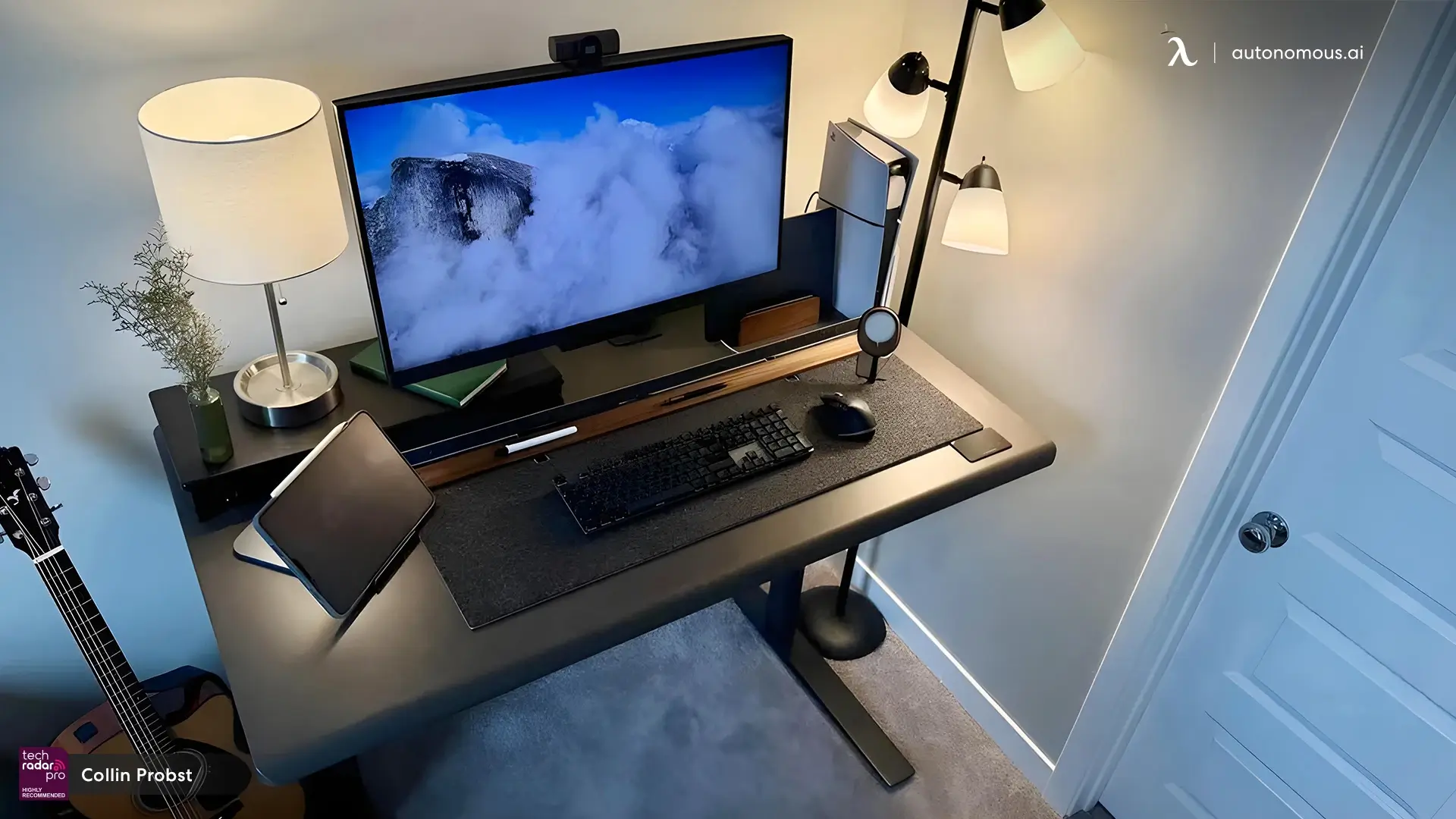
Autonomous Desk 5
| Dimensions | 53"L x 29"W x 1.2"H |
|---|---|
| Colors | Stone Desert, Titanium White, Meteor Grey |
| Coating | Special customize sealing paint based on Green Standard |
| Material | HDF wood |
| Motor type | Dual |
|---|---|
| Lifting speed | 1.2”/sec |
| Lifting capacity | 330 lbs |
| Noise level | 40 dB |
| Height range (without top) | 29.5" - 48.5" |
| Height range (with top) | 30.7" - 49.7" |
| Length range | 40.4" - 70.9" |
| Frame foot width | 26.4" |
| Material | SPCC steel |
| Colors | Stone Desert, Titanium White, Meteor Grey |
| Outlet voltage | 110-240V |
| Anti - collision | Yes |
| Motor type | Dual |
|---|---|
| Lifting speed | 1.6”/sec |
| Lifting capacity | 330 lbs |
| Noise level | 40 dB |
| Height range (without top) | 26" - 51.5" |
| Height range (with top) | 27.2" - 52.7" |
| Length range | 40.4" - 70.9" |
| Frame foot width | 26.4" |
| Material | SPCC steel |
| Colors | Stone Desert, Titanium White, Meteor Grey |
| Outlet voltage | 110-240V |
| Anti - collision | Yes |
Why it's great for back pain:
The gesture controls and smooth responsiveness reduce interruptions and allow you to adjust your posture throughout the day without breaking focus. It’s a desk that learns your routine and adapts with you, making it easier to stay aligned and supported whether you're working, reading, or brainstorming. If you are looking for a standing desk that can serve both 2 missions — stylish and effective, this model should be at the top of your list. You can also remove the height problem, especially if you are a tall person. This one may be the best standing desk for tall people, considering its flexible height adjustment feature.
3. Autonomous Desk 2 L-Shaped
Best for Ergonomic Multitasking and Back-Saving Space Management
This is the powerhouse of the lineup. The Autonomous Desk 2 L-Shaped is built for corner offices, dual-monitor setups, or anyone who needs space to spread out without sacrificing spine support. With triple motors and a large corner layout, the Autonomous Desk 2 L-Shaped supports more equipment and encourages smarter task zoning—ideal for professionals who juggle multiple screens or creative tools. This corner standing desk is perfect for designers, gamers, or coders with dual or triple monitors, business owners or managers with multifunctional desks, or users who share their workspace or want dedicated zones (work vs. leisure).
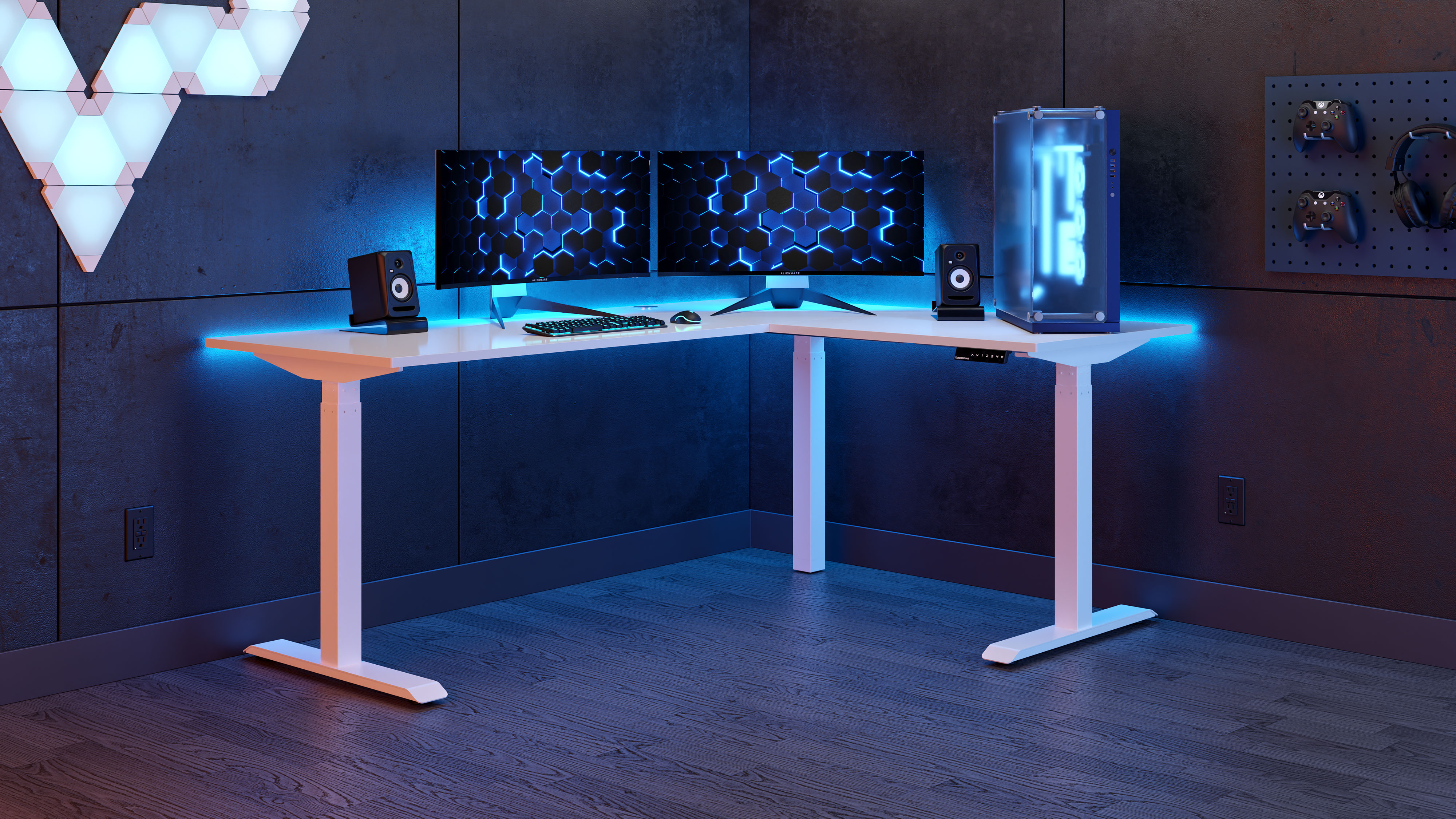
Autonomous Desk 2 L-Shaped
| Dimensions | Full: 77”L x 64”W x 1”H Large Top: 77”L x 29”W x 1”H Small Top: 29”L x 35”W x 1”H |
|---|---|
| Shipping Dimensions | 84"L x 35"W x 5"H x 95 lbs |
| Colors | White, Black, Walnut |
| Material | Warp-proof MDF wood |
| Motor type | Triple |
|---|---|
| Lifting speed | 2.3”/sec |
| Lifting capacity | 400 lbs |
| Noise level | 50 dB |
| Height range (without top) | 28.4" - 47" |
| Height range (with top) | 29.4" - 48" |
| Length range | 42” - 71” |
| Frame foot width | 27.5" |
| Material | SPCC steel |
| Colors | White/ Black |
| Outlet voltage | 110-240V |
| Anti - collision | Yes |
| Shipping Dimensions | Box 1: 54"L x 12"W x 8"H x 51 lbs Box 2: 35"L x 21"W x 9"H x 55 lbs |
Why it’s great for back pain:
This desk gives you room to properly position everything—keyboard, mouse, monitor(s)—to minimize twisting, leaning, or reaching. That translates to healthier neck and back alignment. The lift power also ensures smooth transitions even with heavy gear, which is key to avoiding sudden posture shifts or joint strain.
Tips For Using A Standing Desk Without Hurting Your Back
As someone who’s dealt with lower back pain for years, switching to a standing desk was a game-changer—but only after I developed the right routine. Just owning a standing desk doesn’t automatically mean relief. Here’s how I use mine daily to keep my back comfortable and pain-free, along with tips you can apply too.
Start Slow And Build Up Standing Time
When I first got my standing desk, I didn’t stand for hours right away. I began by standing for about 15 to 30 minutes every hour. Over several weeks, I gradually increased standing time as my body adapted.
My go-to tip:
- As your body adjusts, gradually increase your standing time over a few weeks and sit when needed with your chair. To maximize the advantages of this ergonomic workflow, you can consider going with an office chair for back pain, an orthopedic chair for back pain, or a tailbone pain office chair based on your specific needs.
- You can also integrate some basic and simple standing desk exercises to complete your best working routine.
- Use a timer or a standing reminder app until it becomes a habit, and you can adjust the time spending at your standing desk to avoid other potential cons of standing for long periods.
Maintain Proper Posture When Standing
Getting the right desk height was critical. I made sure my elbows were bent around 90 degrees when typing, and my wrists stayed flat. I also raised my monitor to eye level to avoid leaning forward and causing neck or back strain.
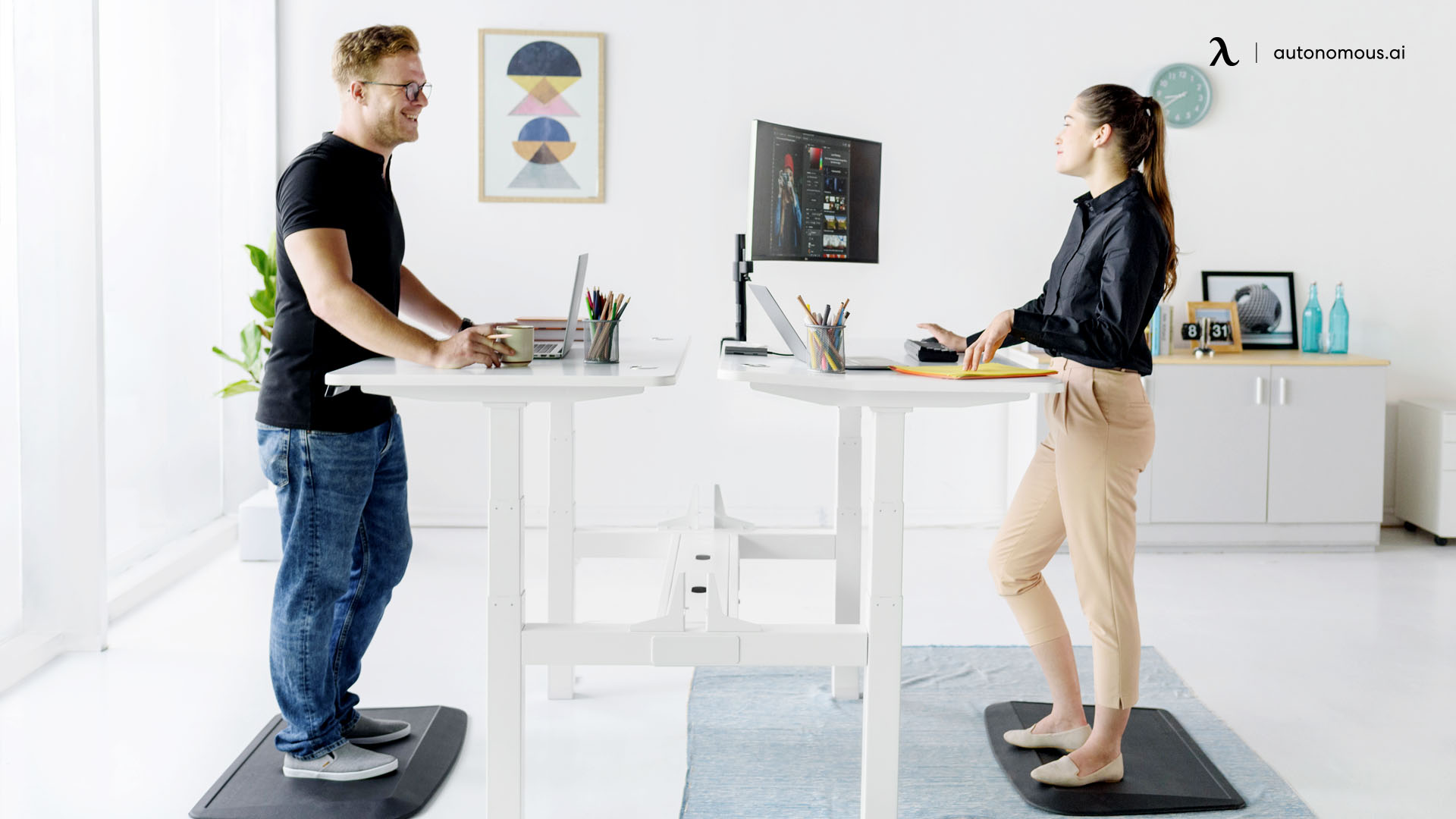
My go-to tip:
When standing at your standing desk for back pain, I recommend paying attention to the proper height of your desk and striving for a harmonious alignment of your body to alleviate pressure on your spine:
- Head: Hold it high and straight, avoiding the inclination to lean forward, creating a confident silhouette.
- Shoulders: Let them drop gently, free from tension, and resist the urge to let them hunch or lift.
- Elbows: Bend them comfortably at about 90 degrees, allowing your wrists to remain straight and poised, ready for action.
- Knees: Maintain a slight bend, soft and relaxed, steering clear of locking them to prevent unnecessary strain on your joints. Standing incorrectly (like slouching, leaning, or locking your knees) can be just as harmful as poor sitting posture.
Use Supportive Accessories To Maximize The Comfort
I invested in an anti-fatigue mat to cushion my feet and reduce pressure on my lower back while standing. I also tried a bunch of fun, different accessories like a leaning stool for standing desk breaks or a balance board—this helps relieve leg fatigue without fully sitting down, which keeps my muscles engaged. The potential to enhance your posture is unlimited!
For days when I want to add more activity, I pair my desk with an under-desk treadmill or a walking pad for a standing desk. This keeps me moving gently and burns calories while I work. However, if you are interested in incorporating an under-desk treadmill, I highly recommend that you should consider a standing desk for treadmill to achieve the best height adjustment and match with your constant movement.
My go-to tip:
If you find it is a bit boring while standing at your height-adjustable desk, you can find different ways to incorporate into your standing time, such as:
- Moving with a balance board, dancing, or massaging your feet on a standing mat to boost your movement and creativity.
- Switching to an under-desk treadmill if you do not have much time for a later workout at the gym.
- A couple of stretches to prevent feet from swelling while standing.
I believe that working in 2025 is not only about dedicating the most important assets to your boring sitting desk. Working in modern times is a harmony between work and ergonomics with smart movements.
FAQs
1. Does a standing desk help with back pain?
Yes, when used correctly, a standing desk can help relieve back pain by reducing pressure on the lower spine, encouraging better posture, and allowing more natural movement throughout the day. It’s most effective when paired with ergonomic adjustments and regular position changes.
2. How often should I stand at my desk?
Aim for 30 to 60 minutes of standing every 1–2 hours. Listen to your body and gradually increase your standing time.
3. Do I need a special chair with a standing desk?
An ergonomic chair is still important for the seated portion of your day. Look for one with lumbar support and adjustable features.
4. What if standing makes my back hurt more?
That could mean your posture or desk height isn’t right. Make sure your monitor is at eye level and your elbows are at a 90-degree angle.
5. Do chiropractors recommend standing desks?
Yes. Many chiropractors recommend standing desks to reduce prolonged sitting, which contributes to lower back pain and poor posture. They often emphasize the importance of alternating between sitting and standing and setting up the desk correctly to avoid new issues.
6. Is a standing desk actually healthier?
Yes. When used the right way, standing desks can jazz up your work routine. They help improve your posture, lower the risk of muscle strain, and might even give your energy and focus a nice boost! Just remember, the secret is to keep moving around instead of staying in one spot. Enjoy those standing hours!
7. Is standing all day better than sitting for back pain?
No. Standing all day can lead to fatigue and new discomfort in the legs or lower back. The best approach is to alternate between sitting and standing every 30 to 60 minutes. Movement—not just standing—is the key to reducing pain.
8. What is the best standing desk position to reduce lower back pain?
Your elbows should be at a 90-degree angle when typing, your wrists should be straight, and your monitor should be at eye level. Keep your shoulders relaxed and avoid locking your knees. This helps maintain spinal alignment and reduces stress on your lower back.
9. How long should I stand at my standing desk each day?
Start with standing for about 15–30 minutes every hour. Aim for a total of 2–4 hours of standing per workday, broken into intervals. Over time, you can increase your standing time as your body adapts.
10. What should I look for in a standing desk if I have lower back pain?
If you are searching for a standing desk for back pain, you may want to ponder these ideal features that a standing desk must have to support your working routine:
- A wide height range to fit your body
- Smooth, stable height adjustments (ideally electric)
- Enough surface space to position your monitor at eye level
- Options for ergonomic accessories like monitor arms and keyboard trays
Conclusion
Back pain doesn’t have to be a permanent part of your workday. A standing desk is one of the smartest ergonomic investments you can make—it transforms how your body interacts with your workspace. When paired with good posture, movement habits, and supportive accessories, it becomes more than just a desk. It’s a step toward lasting comfort, better focus, and a healthier back. So if you’ve been asking, “is a standing desk good for back pain?”—now you know: yes, when chosen and used thoughtfully, it is.
Spread the word
.svg)


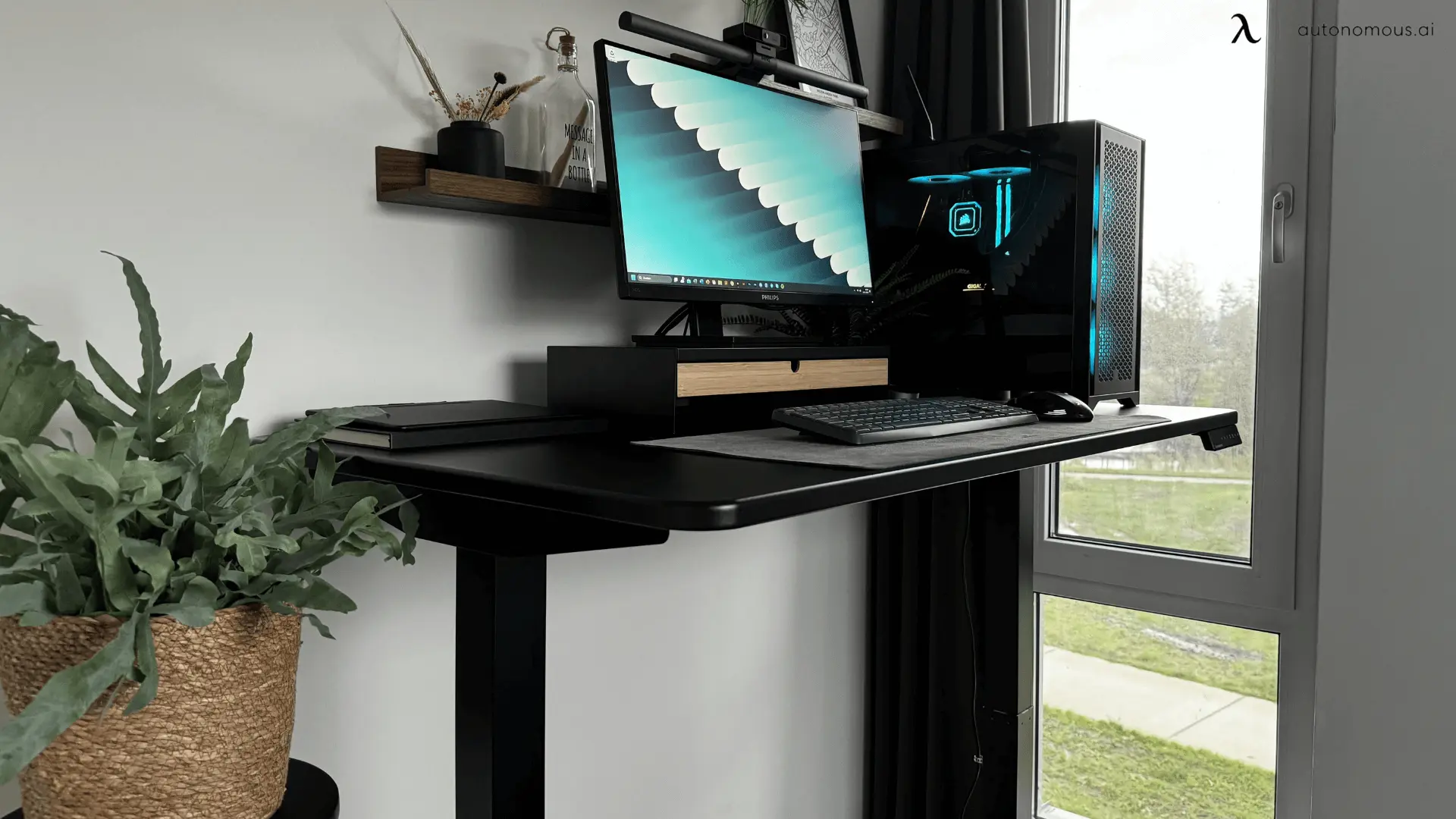
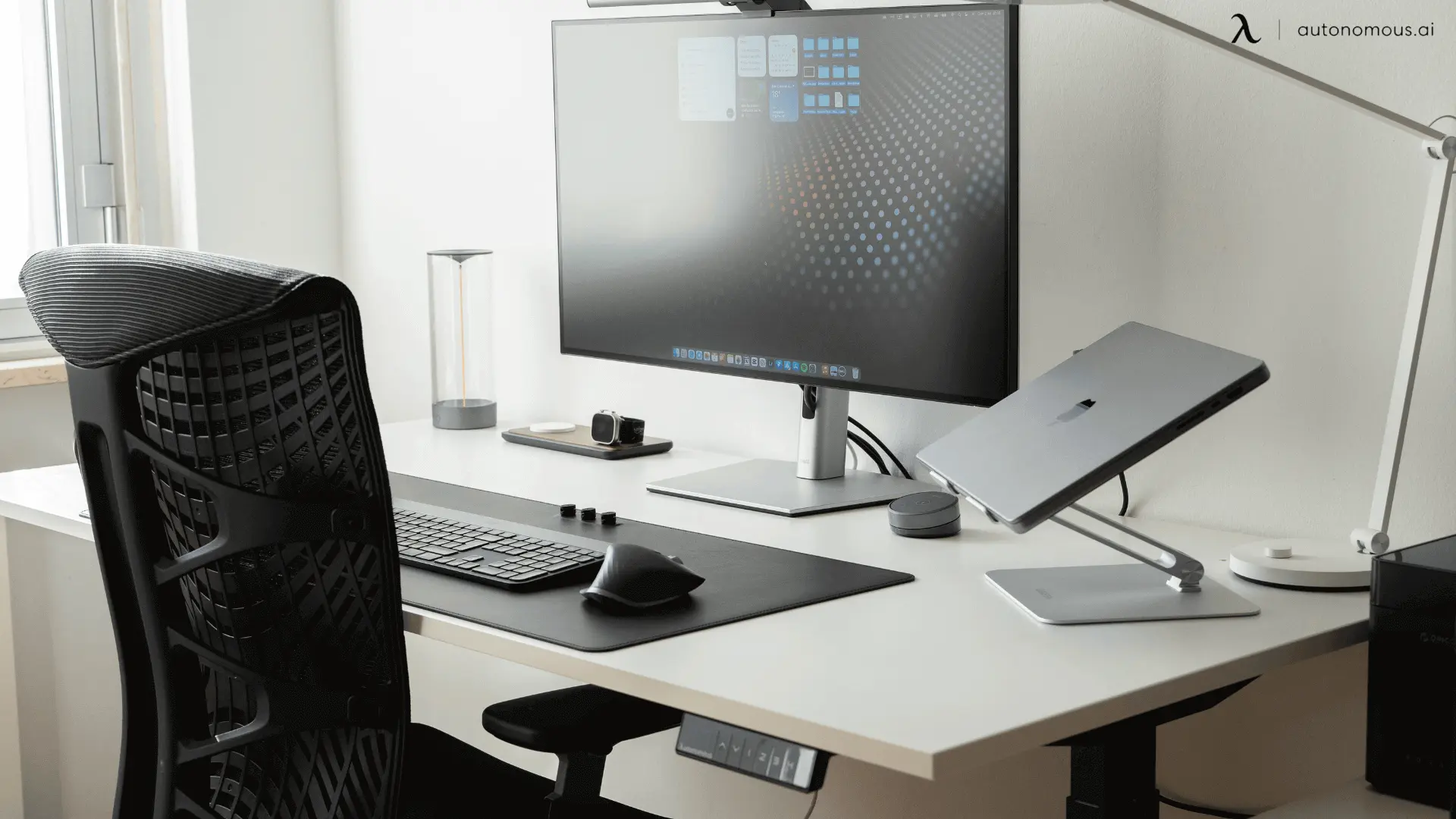
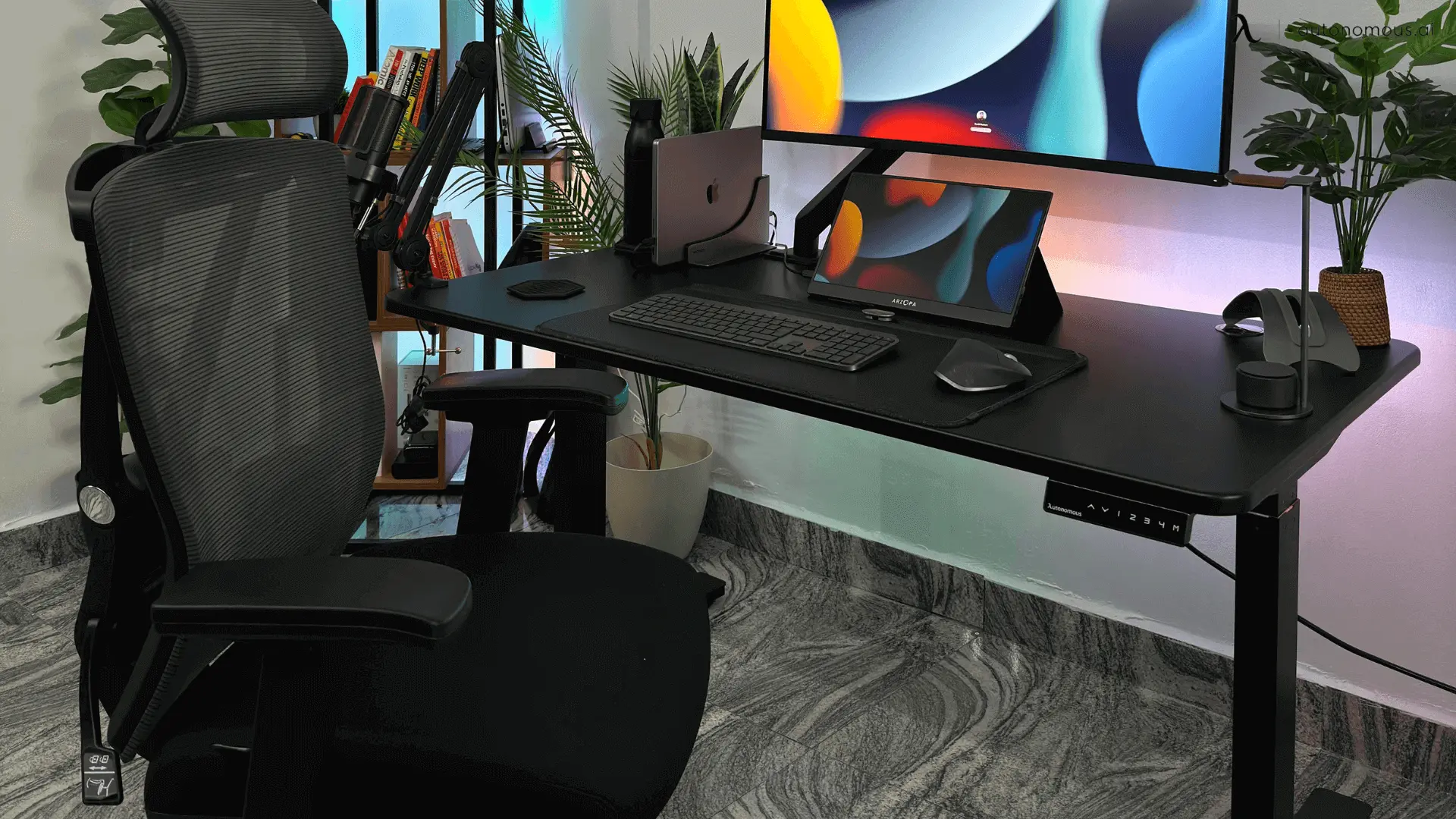
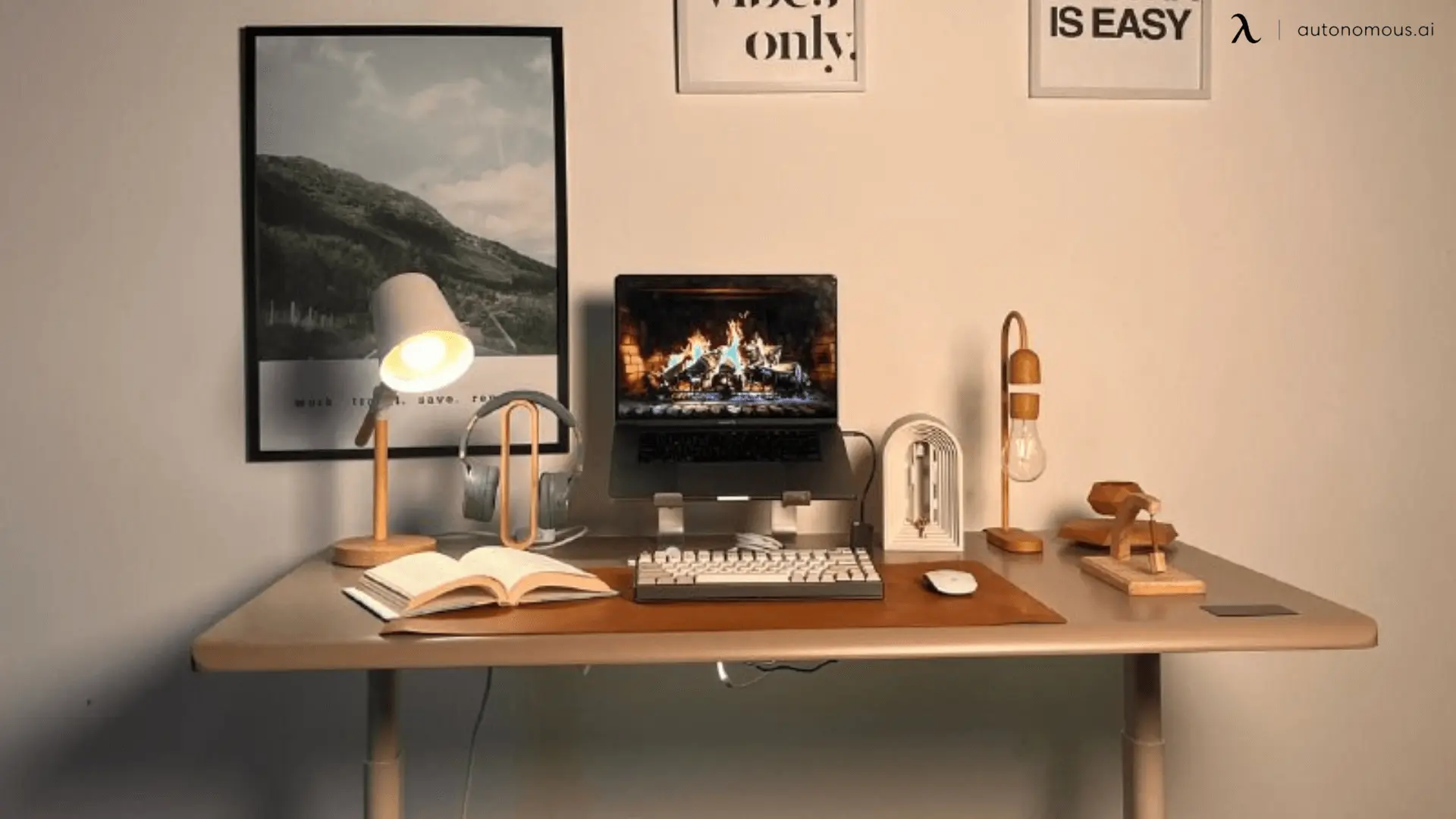
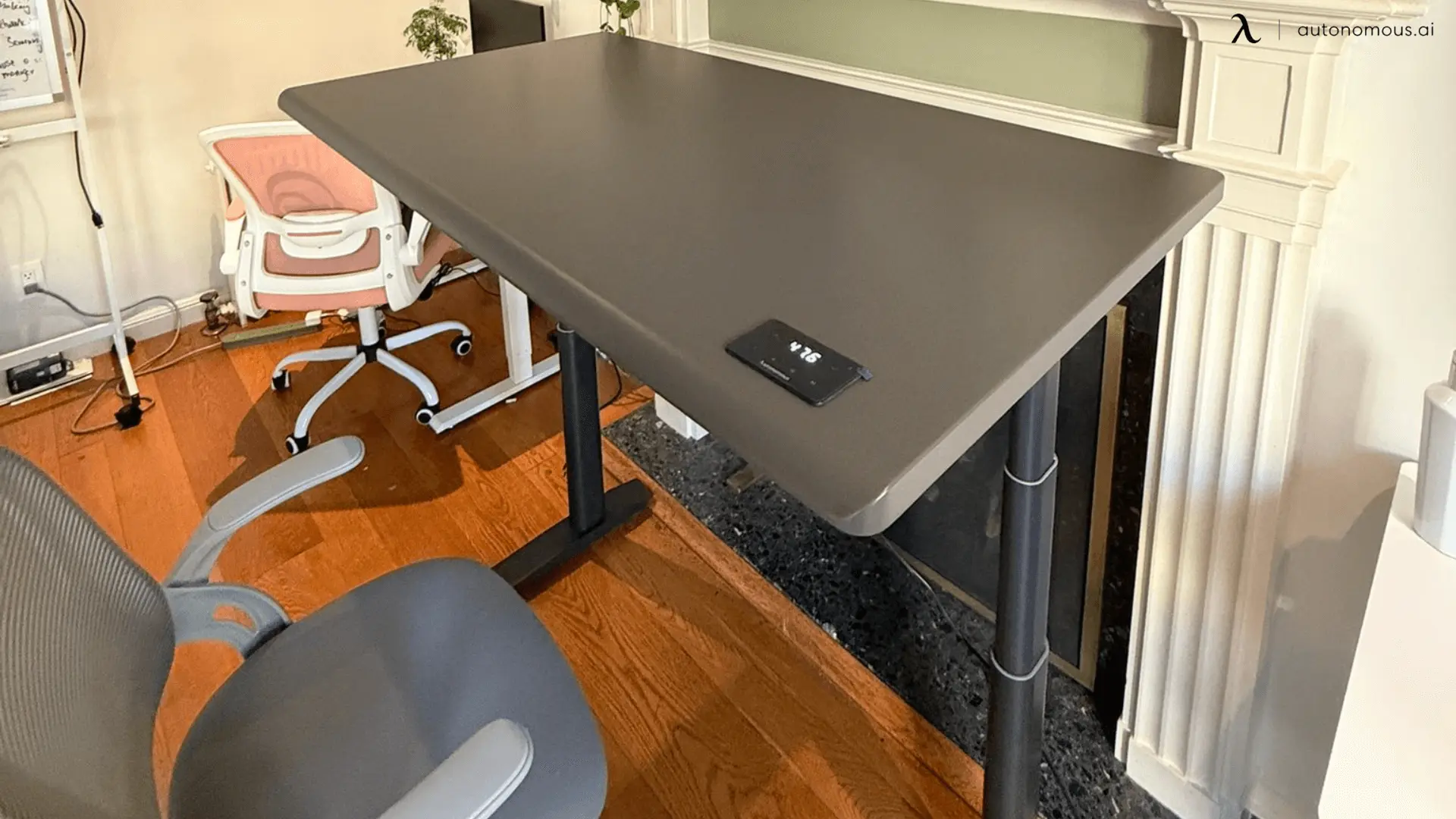
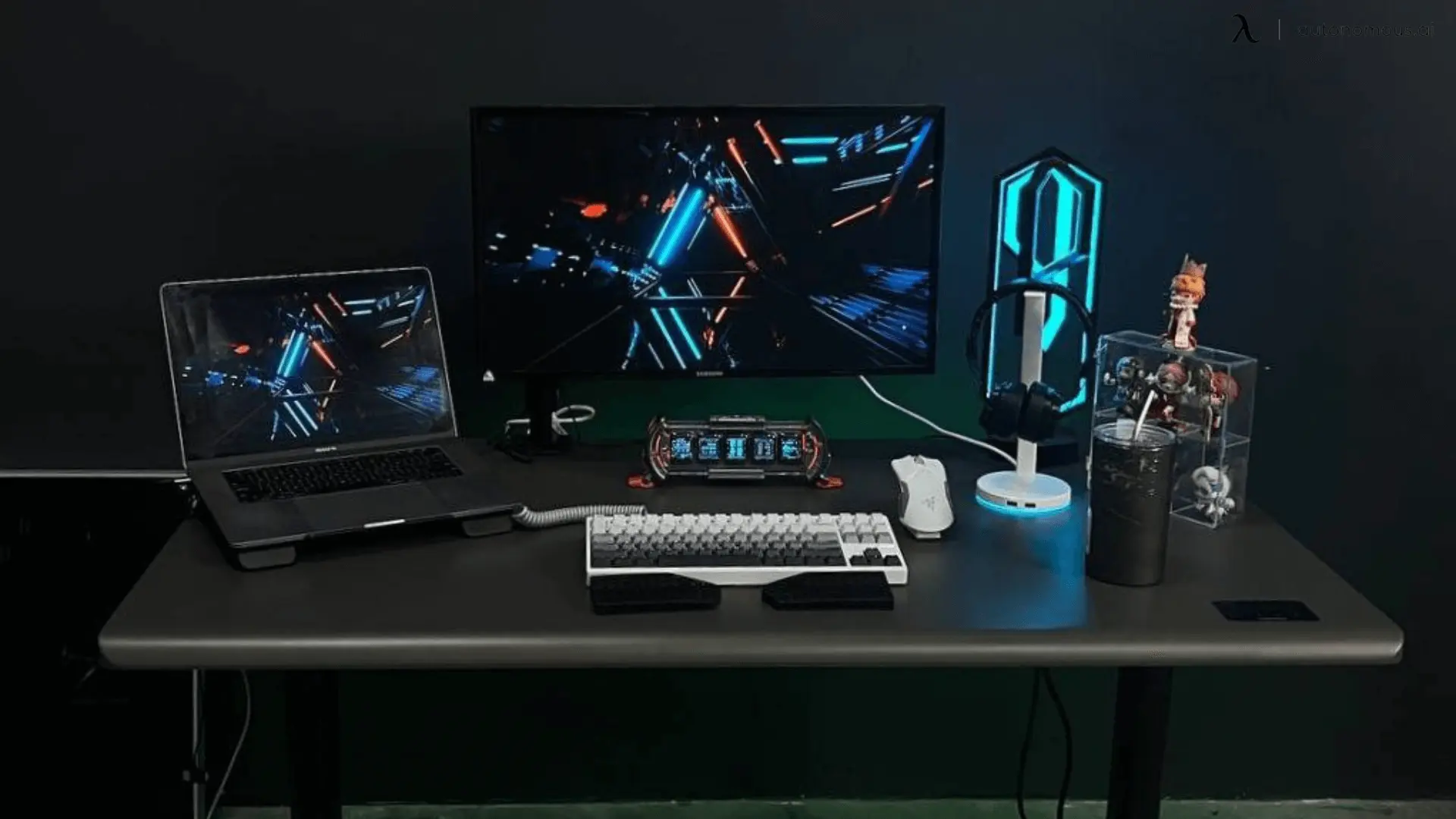
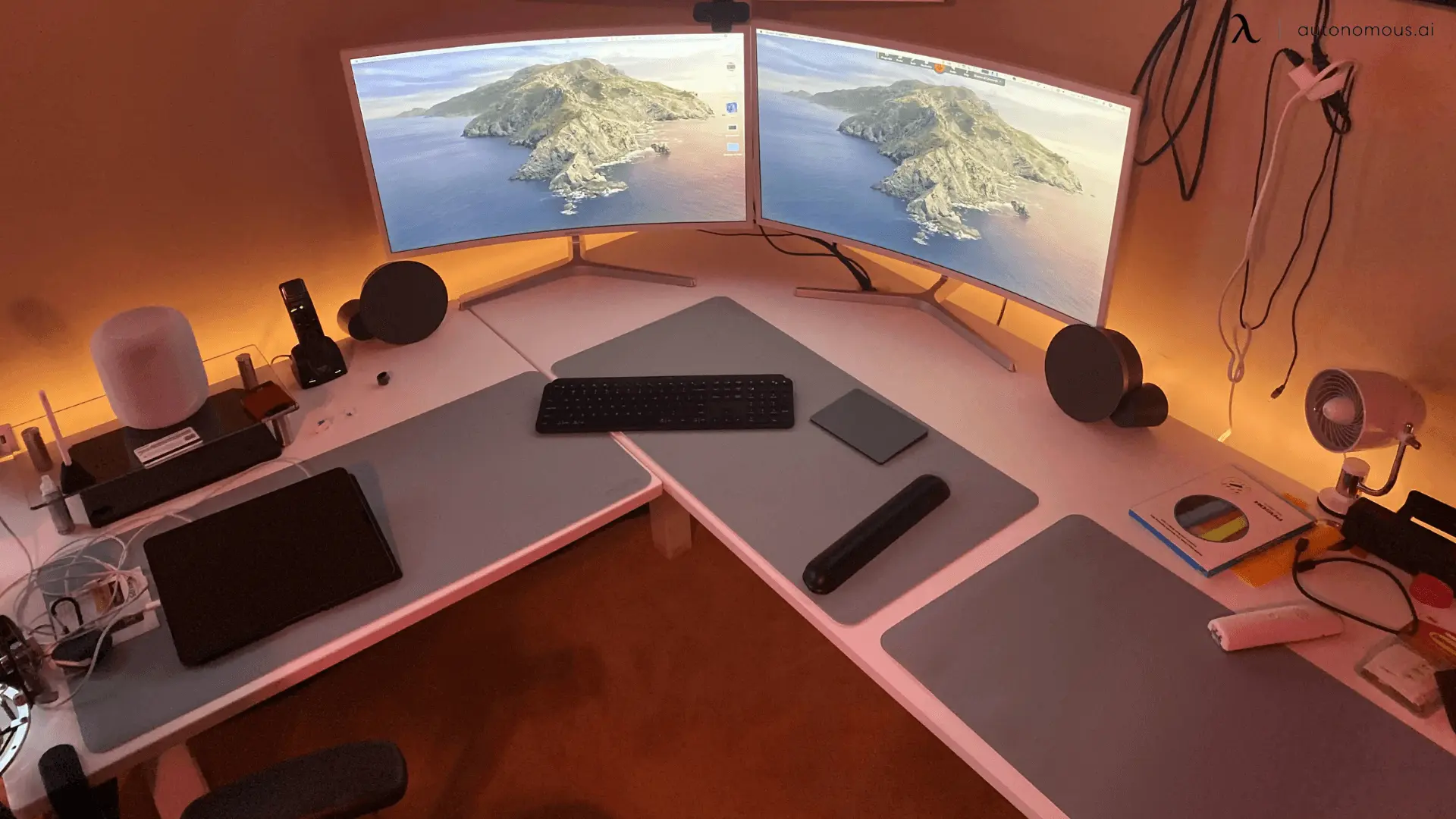
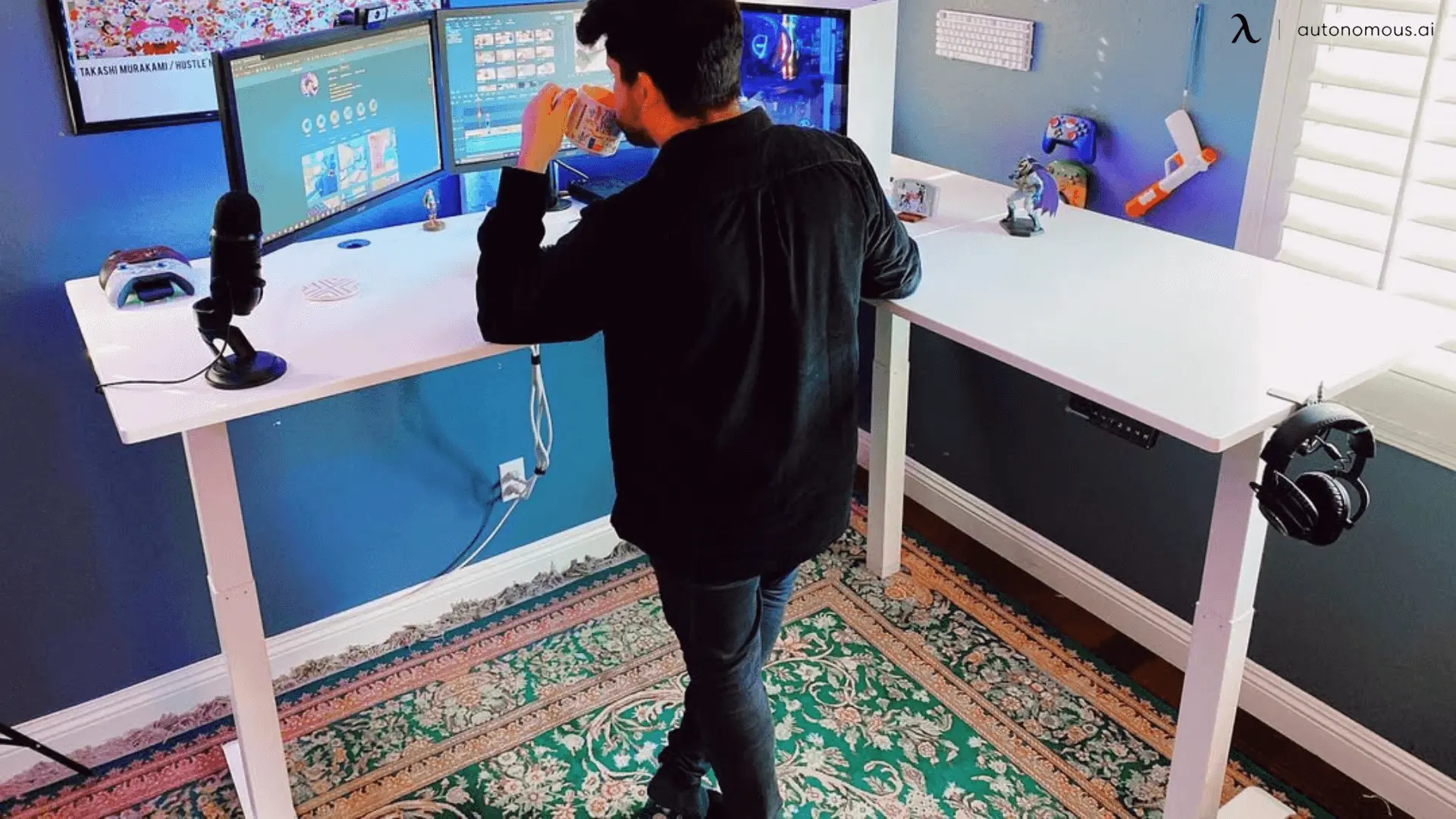
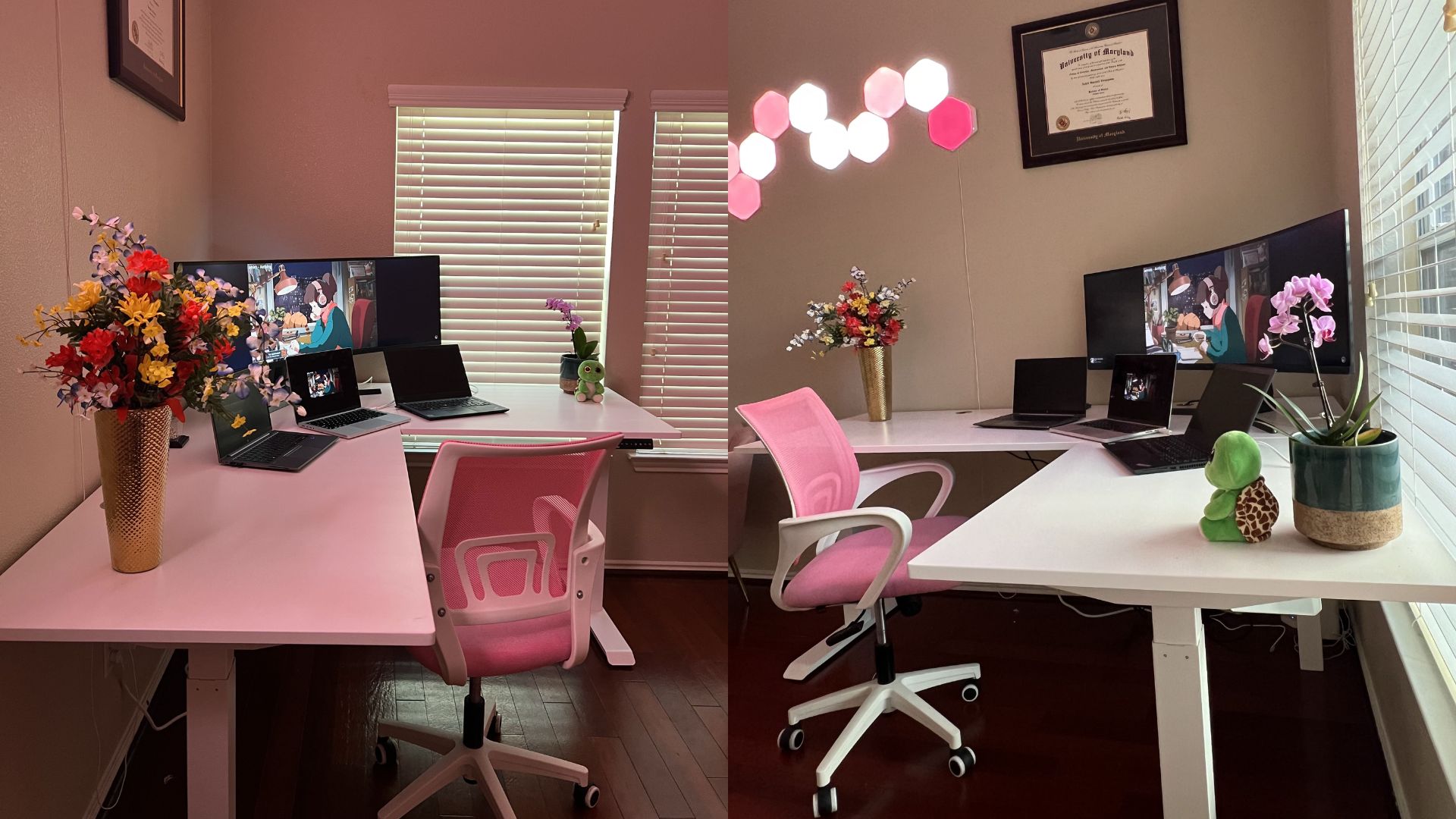
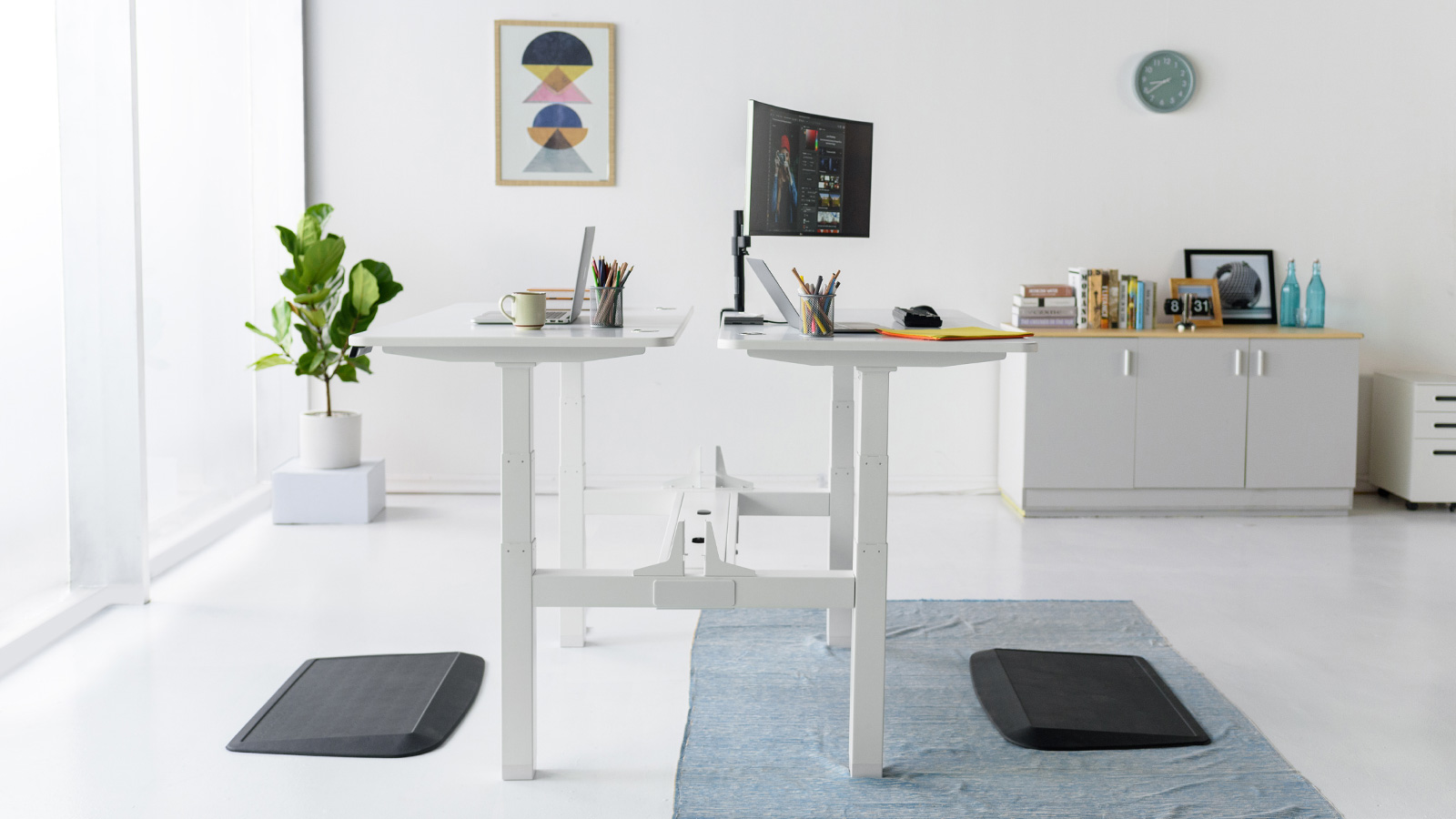
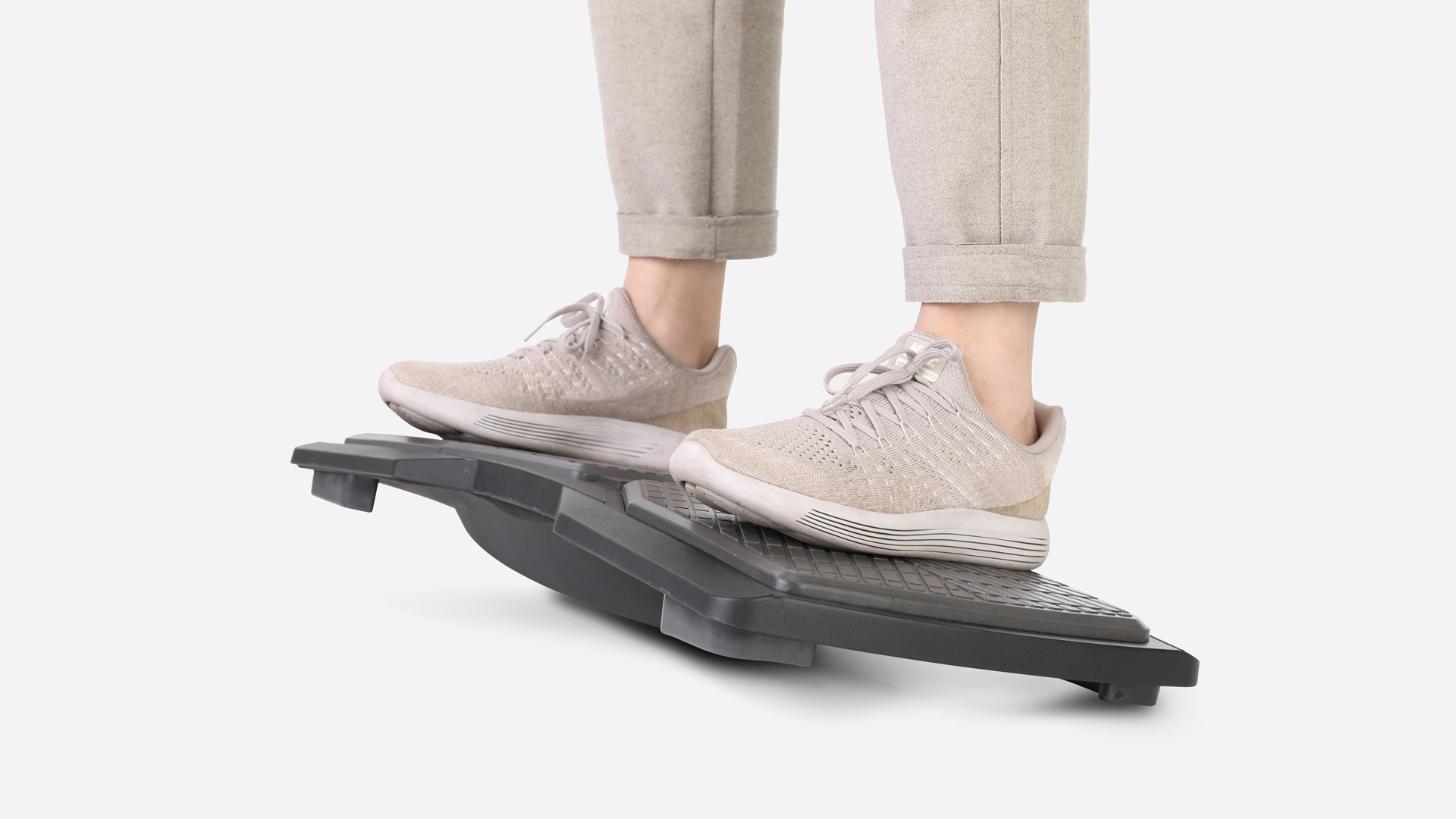


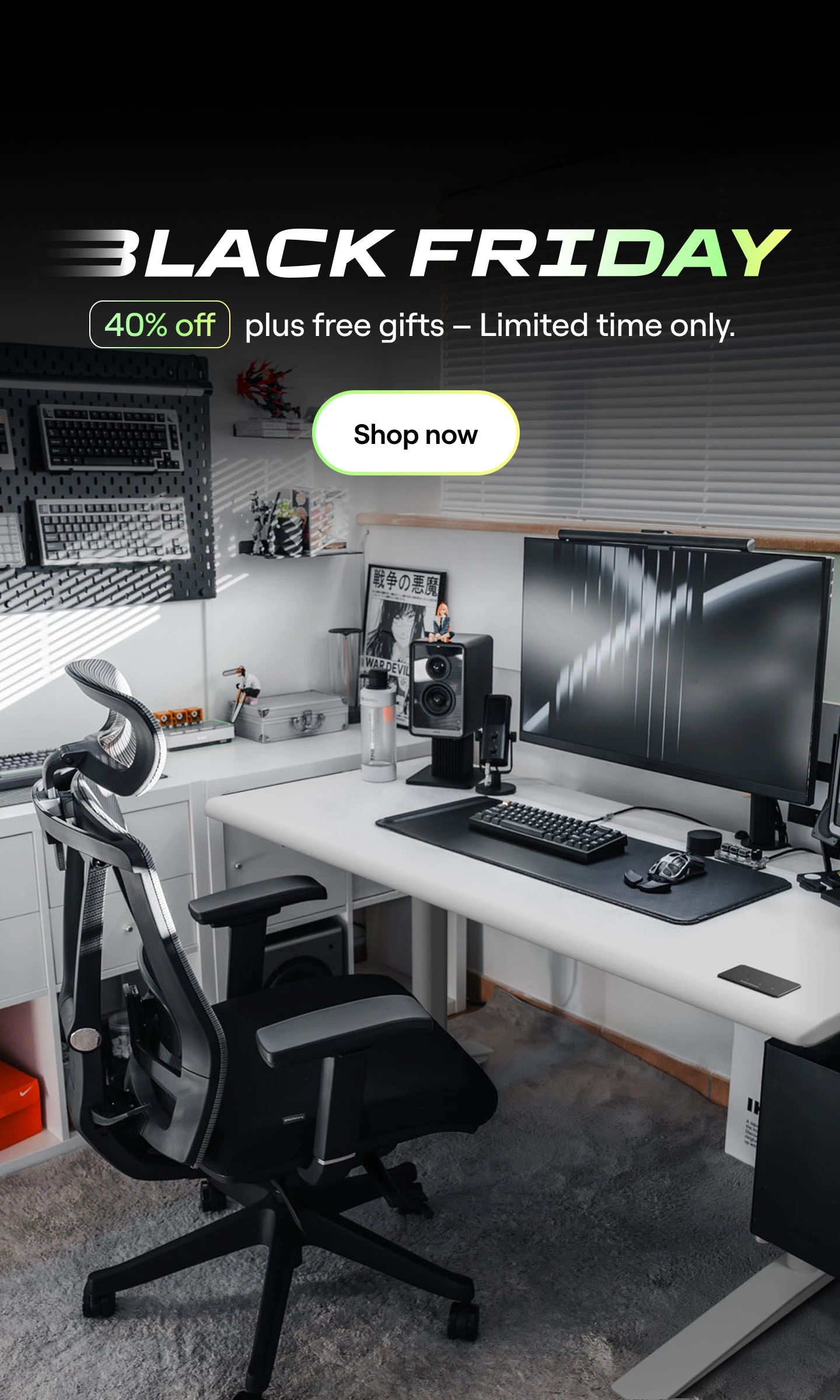
(1).webp)

